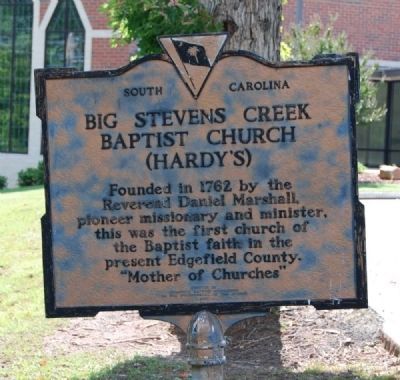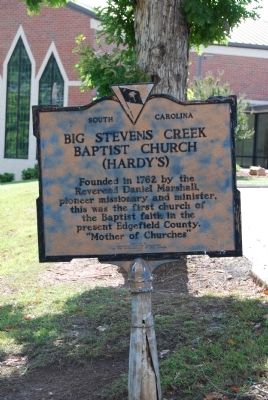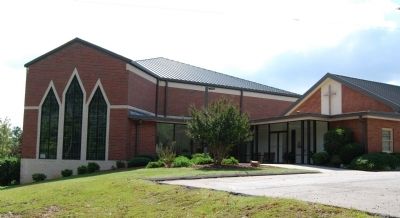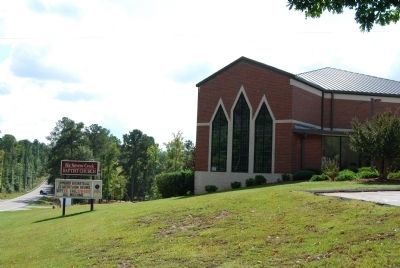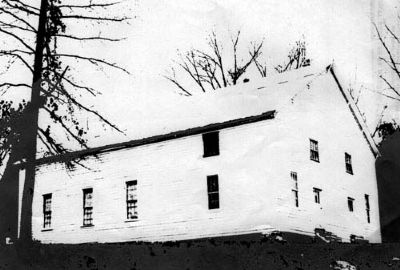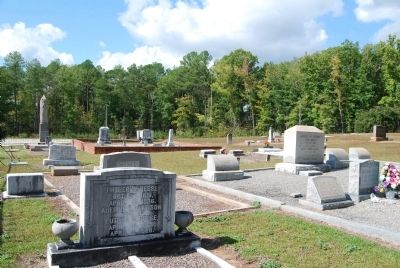North Augusta in Edgefield County, South Carolina — The American South (South Atlantic)
Big Stevens Creek Baptist Church (Hardy's)
Founded in 1762 by the Reverend Daniel Marshall, pioneer missionary and minister, this was the first church of the Baptist faith in the present Edgefield County, "Mother of Churches."
Erected 1962 by Edgefield Baptist Association on the Bicentennial of the Church. (Marker Number 19-2.)
Topics. This historical marker is listed in these topic lists: Churches & Religion • Colonial Era. A significant historical year for this entry is 1762.
Location. 33° 36′ N, 82° 1.059′ W. Marker is in North Augusta, South Carolina, in Edgefield County. Marker is on West Martintown Road, on the left when traveling north. Touch for map. Marker is at or near this postal address: 1850 West Martintown Road, North Augusta SC 29860, United States of America. Touch for directions.
Other nearby markers. At least 10 other markers are within 8 miles of this marker, measured as the crow flies. Birthplace of General James Longstreet (approx. 2˝ miles away); Lt. General James Longstreet (1821-1904) (approx. 2˝ miles away); The Fall Line and Headgates (approx. 3.6 miles away in Georgia); The Old City Locks (approx. 3.7 miles away in Georgia); The Martintown Road (approx. 5˝ miles away); Samuel Hammond (approx. 7.2 miles away); Hampton Terrace Hotel (approx. 7.3 miles away); North Augusta (approx. 7.6 miles away); Meriwether Monument (approx. 7.6 miles away); James Urquhart Jackson (approx. 7.6 miles away). Touch for a list and map of all markers in North Augusta.
Also see . . .
1. Welcome - Big Stevens Creek Baptist Church. Official website of Big Stevens Creek Baptist Church. (Submitted on December 27, 2009, by Brian Scott of Anderson, South Carolina.)
2. Big Stevens Creek Baptist Church. Founded in 1762 by the Reverend Daniel Marshall, the Big Stevens Creek Baptist Church was built in 1776 in the meeting house style. The church was listed on the National Register from May 6, 1971 until December 8, 2005 when the original building was demolished. (Submitted on October 22, 2008, by Brian Scott of Anderson, South Carolina.)
Additional commentary.
1. Big Stevens Creek Baptist Church
Plain rectangular building of white clapboard siding with amble roof, sometimes referred to as "Meeting House Style" architecture. Width: four bays, middle two are single doors (not original) with vertical glass panes in top section. Length: four bays. Windows are of double sash type with clear panes. Wooden steps. Fieldstone foundation piers.
Interior -- handhewn pews and wall board covering. Pews are fastened together with pegs. Center post in middle of auditorium helps support roof. Two side aisles lead to raised pulpit platform. Balcony has been divided into church school rooms.
Significance
Founded in 1762 by the Reverend Daniel Marshall, who was influenced by George Whitefield so that he spent the remainder of his life in religious work. Marshall became one of the strongest of New England “New Light” missionaries, looking for the immediate Second Coming of Christ. He was converted to “Separate Baptists” – a sect characterized as highly emotional, noisy, suspected of Arminianism and disposed to allow women prominence in religious work. Since the “Regular Baptists” were intolerant of the “Separates,” the latter transferred their missionary efforts to the backcountry settlers of Virginia, North Carolina, South Carolina and Georgia.
Marshall’s coming into the western section of South Carolina marked the beginning of Baptist work in the territory that later became Edgefield Baptist Association.
Big Stevens Creek Church may in truth be called "Mother of Churches," for from it radiated many churches in South Carolina. It is also responsible for first establishing its denomination in Georgia.
Marshall continued for some years as minister of Big Stevens Creek Baptist Church. In 1772 he was assisted by his son Abraham Marshall, and by Benjamin Perry, Saunders Walker and John Herndon.
At that time the church was a member of Congaree Association, having been dismissed from the Sandy Creek “Separate” Association; however, the “Separate” peculiarities of service were retained. The present austere "Meeting House Style" church was constructed in 1776 and exhibits many original features. (Source: National Register nomination form.)
— Submitted December 27, 2009, by Brian Scott of Anderson, South Carolina.
Credits. This page was last revised on November 15, 2020. It was originally submitted on October 22, 2008, by Brian Scott of Anderson, South Carolina. This page has been viewed 1,858 times since then and 53 times this year. Photos: 1. submitted on December 27, 2009, by Brian Scott of Anderson, South Carolina. 2, 3, 4. submitted on October 22, 2008, by Brian Scott of Anderson, South Carolina. 5. submitted on December 27, 2009, by Brian Scott of Anderson, South Carolina. 6. submitted on October 22, 2008, by Brian Scott of Anderson, South Carolina.
